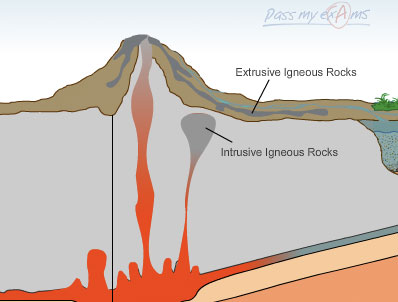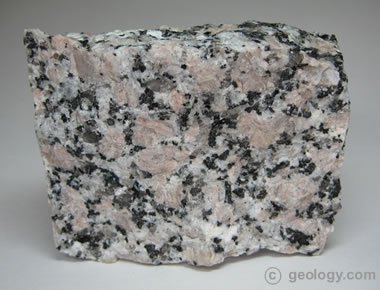Ingeous Quiz

- 1.
Igneous comes from the Latin word IGNIS meaning
- A.
Water
- B.
Fire
- C.
Ice
- D.
Air
Correct Answer
B. Fire -
- 2.
Igneous rocks form when rocks and minerals
- A.
Are cemented and compacted together
- B.
Are changed from high heat and pressure
- C.
Are weathered into sediments
- D.
Melt then cool
Correct Answer
D. Melt then cool -
- 3.
Extrusive igneous rocks will have
- A.
Large crystals and cool slowly
- B.
Large crystals and cool quickly
- C.
Small crystals and cool slowly
- D.
Small crystals and cool quickly
Correct Answer
D. Small crystals and cool quickly -
- 4.
Intrusive igneous rocks have larger crystals because they cool slowly
- A.
On the surface of the crust
- B.
Inside Earth's crust
- C.
In oceans
- D.
When they mix with air
Correct Answer
B. Inside Earth's crust -
- 5.
This rock, granite, is
- A.
Intrusive and fine grain
- B.
Extrusive and fine grain
- C.
Intrusive and coarse grain
- D.
Extrusive and coarse grain
Correct Answer
C. Intrusive and coarse grain -
- 6.
Felsic igneous rocks like rhyolite and granite have
- A.
65%-75% silica (SiO2)
- B.
55%-65% silica (Si O2)
- C.
45%-55% silica (Si O2)
- D.
Less then 45% silica (Si O2)
Correct Answer
A. 65%-75% silica (SiO2) -
- 7.
Felsic Igneous rocks like rhyolite and granite have 65%-75% silica (SiO2) and are high in
- A.
Potassium (K) Iron (Fe) Magnesium (Mg)
- B.
Aluminum (Al) Potassium (K) Sodium (Na)
- C.
Aluminum (Al) Magnesium (Mg) Iron (Fe)
- D.
Aluminum (Al) Magnesium (Mg) Calcium (Ca)
Correct Answer
B. Aluminum (Al) Potassium (K) Sodium (Na) -
- 8.
A mafic igneous rock such as basalt has a composition that is high in Iron (Fe) and Magnesium (Mg) and about
- A.
65%-75% silica
- B.
55%-65% silica
- C.
45%-55% silica
- D.
Under 45% silica
Correct Answer
C. 45%-55% silica -
- 9.
We know different minerals have different melting points (and cooling/solidifying points). Bowen's Reaction Series shows us the mineral Olivine (high in Iron-Fe, Magnesium-Mg, and Calcium-Ca) is the last to melt and first to
- A.
Start crystallizing as it cools
- B.
Turn into sedimentary rock
- C.
Turn into silica
- D.
Wrong answer
Correct Answer
A. Start crystallizing as it cools -
- 10.
Looking at Bowen's Reaction Series: Olivine and Pyroxine are
- A.
Mafic
- B.
Felsic
- C.
Intermediate
- D.
Wrong answer
Correct Answer
A. Mafic -
- 11.
Looking at Bowen's Reaction Series: What rocks are the last to form (crystallize at the coolest temperatures)
- A.
Andesite diorite
- B.
Basalt gabbro
- C.
Granite and Rhyolite
- D.
Muscovite and quartz
Correct Answer
C. Granite and Rhyolite -
Quiz Review Timeline +
Our quizzes are rigorously reviewed, monitored and continuously updated by our expert board to maintain accuracy, relevance, and timeliness.
-
Current Version
-
Sep 14, 2018Quiz Edited by
ProProfs Editorial Team -
Oct 23, 2014Quiz Created by
Forddw123
- Continent Quizzes
- Earth Science Quizzes
- Easy Geography Quizzes
- Environment Quizzes
- Fictional Geography Adults Quizzes
- Five Themes Of Geography Quizzes
- Geology Quizzes
- Human Geography Quizzes
- Imperialism Quizzes
- Island Quizzes
- Land Quizzes
- Latitude And Longitude Quizzes
- Location Quizzes
- Nation Quizzes
- Nature Quizzes
- Navigation Quizzes
- Ocean Quizzes
- Physical Geography Quizzes
- Planet Quizzes
- Regional Geography Quizzes
- Remote Sensing Quizzes
- World Quizzes
- World Geography Quizzes
 Back to top
Back to top




